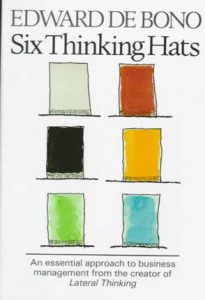“Yes we can do that!” I have a habit, perhaps a weak spot, of building upon people’s ideas. It is the opposite of the automatic “no” that often comes from management. While the art of the possible can contribute to original, outside-the-box solutions, there often are other facets that need to be considered.
Like all CEOs, I have a business to run. My colleagues’ livelihoods depend on me maintaining a healthy bottom line, and my clients’ success depends on us guiding the best use of their hard-earned dollars and forging strong professional relationships.

Edward de Bono
To achieve this balance, I keep in mind a method that I discovered years ago in a book called “Six Thinking Hats” by Edward de Bono. I reread this book every few years, and it continues to remind me that I must consider every angle before making decisions that will affect my company’s and my clients’ well-being.
According to de Bono, each of us naturally follows a certain thinking pathway, which he describes as the six thinking hats:
· White: data-driven
· Red: emotional
· Black: cautious
· Yellow: optimistic
· Green: creative
· Blue: organized
The premise of the book is simple, but the implementation can be complex. Only by forcing ourselves to think differently will we be able to make truly thoughtful decisions.
How to use the six thinking hats method
Everyone involved in the decision-making process should (metaphorically) wear each of the aforementioned hats in every discussion. It does not necessarily need to reflect your point of view. For instance, you may be in favor of an idea, but for purposes of making an executive discussion you would wear the black (cautious) hat. It’s one thing to hear someone’s opinion and appreciate their ideas. It’s a different ballgame when you put yourself in their position and really consider the effects of a decision from that point of view.

Six Thinking Hats
It can be frustrating at times to discuss a topic you’re passionate about with someone who might want to change your idea or play devil’s advocate. But it’s vital to have these conversations. If we default only to our most comfortable point of view (for me, the yellow hat that signifies positivity and service orientation), we create blind spots in our decision-making process. I prefer to surround myself with people who think differently than me. Doing so ensures that my blind spots are covered, even when it’s tough to wear some of the hats I must as a CEO. Think of it this way: If you’re right, say, 75 percent of the time, that means you’re wrong 25 percent of the time. To me, Six Hats engenders clinical decision-making resulting in better outcomes.
I encourage you to read “Six Thinking Hats” by Edward de Bono. While the idea of role-playing at work might be daunting or uncomfortable at first, remember that change rarely is easy.

